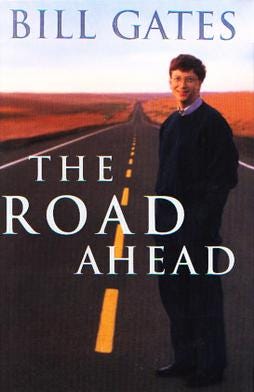Is Technological Innovation Random?
Revisiting QWERTY in 2025
Reading the headlines of CNBC or the New York Times can make technological innovation seem totally random. From Ozempic to ChatGPT, progress seems all over the place. But those closer to the technology are always less surprised. They’ve watched the research develop, enabling them to see the field's trajectory. Bill Gates, for instance, anticipated much about the internet with his 1995 book The Road Ahead, primarily because he was at the coalface of the information revolution.
To historians, trajectories are a source of endless fascination because they raise the question, “Were other trajectories possible, or was this the only path?” As I watch GenAI eat the world, I find myself wondering this often. Was this technology inevitable, or were there other paths? Is this locking us into something else? How will potential regulation affect this path?
Thankfully, the economic historians have given us some helpful concepts to clarify our thinking on this topic, using keyboards, of all things, to illustrate the concept. So, in this post, I’ll bring their ideas to light so I can use their vocabulary later on.
Keyboard Layouts
Look down at your keyboard. Unless you’ve purchased a very obscure device, you'll note that the upper right-hand letters on the keyboard are “QWERTY.” If you’re reading this on your phone, try forwarding this article via text (shameless, I know) and look at the keyboard that pops up - still QWERTY!
Way back in 1985, the economic historian Paul David famously asked why this was the case. Why not use a more logical layout? Couldn’t keyboards go in alphabetical order, or have all the vowels together? QWERTY seems entirely arbitrary.1
The reason your iPhone uses QWERTY in texts goes all the way back to the mid-19th century. In the 1860s, the telegraph was growing and businesses were becoming large, professional operations, creating lots of demand for typewritten notes. This made typewriters essential for the newly created class of secretaries writing notes, minutes, memos, and letters.
However, typewriters were a nascent technology, and manufacturers were still working through the kinks, namely, jamming (something they never truly solved, in my very limited experience). When typists worked too quickly, the gears on the typewriter would smash into each other, jamming the typewriter and creating a mess. To address this, inventor Christopher Sholes developed a new model for Remington in 1874 that used the QWERTY layout to space letters in a manner that made it unlikely for an English speaker ever to need to type letters next to each other. For instance, the T and the H are in different rows, so if one hits them quickly, they would have a lot of physical space between them on the keyboard.
While this new layout limited jams, the weird layout didn’t go unnoticed. In the 20th century, new keyboard layouts emerged to challenge QWERTY. Famously, August Dvorak developed the Dvorak Simplified Keyboard in 1936, which promised a faster, more ergonomic alternative. Dvorak’s design placed the most-used letters on the home row and aimed to minimize finger movement. During World War II, the U.S. Navy even conducted experiments retraining typists on Dvorak’s layout to boost typing speeds.
Was the Dvorak faster at typing? These results are tedious, requiring the poor secretaries to effectively take different Mavis-Beacon courses and compare their words-per-minute. David argued that other formats were faster, but millions of typists had learned QWERTY, and businesses and schools had invested heavily in it, so switching costs were enormous. In short, QWERTY had built up a powerful network effect – the more people used it, the more beneficial it was to keep using it. Even if switching to Dvorak, or some other format, could make a given typist faster, the coordination costs were daunting: who would retrain all the typists and remake all the keyboards? Thus, the first layout gained a self-reinforcing lead.
That’s not to say there hasn’t been some debate about this. The most influential critique came from economists Stan J. Liebowitz and Stephen E. Margolis, who published a paper in 1990 pointedly titled “The Fable of the Keys.” Liebowitz and Margolis argued that, in fact, Dvorak, QWERTY, and other formats are roughly equally efficient, and were very skeptical of the more extreme version of David’s argument, that we got ‘trapped’ in an inefficient standard.2
The interesting point is not the words-per-minute debate, but the simple fact that we ended up with a very arbitrary layout simply because of a mechanical issue that dates back nearly to the Civil War. Regardless of 20th-century secretary speeds, my 2025 Netflix screen retains this 19th-century layout not because it’s optimal, but because it’s become the standard we expect.
Beyond Keyboards
While all this sounds academic, path dependence has critical social ramifications. Once research begins on a trajectory, or society sets a path, it can be challenging to shift from that path. Just to provide a couple more technological examples:
Automakers tried many designs in their early years, ultimately settling on internal combustion engines as the ‘dominant design’ of the industry for various reasons. Once adopted, switching back to electric vehicles (first invented in 19th-century Germany) has become immensely painful.
After the crisis of Chernobyl, the world moved strongly against nuclear energy, preferring the ‘safety’ of fossil fuels. The result has been poorer air quality, climate change, and increasingly high energy prices.
But this principle doesn’t just apply to technologies; it’s also true of regulations. For instance:
The US developed an insurance-based healthcare model after WWII because the government set up wage controls, incentivizing employers to pay employees via insurance, not wages. But, in so doing, it’s become nearly impossible to move to any other system, given that people are now dependent on their insurance, as the Obama Administration famously learned.
During the Cold War, the US passed several laws requiring airlines to be domestically owned. Despite the end of the Cold War, the law remains in place, prohibiting the best of both luxury and budget airlines from coming to the US, and maintaining relatively high prices and low service quality.
In thinking through these examples, it’s helpful to be a bit more precise in the terminology by distinguishing between two related concepts:
Path dependence, as described above, is a general term for heading in a specific direction. Internal combustion engines and QWERTY keyboards being two famous examples.
Technological lock-in is a stronger form of path dependence. It implies the commitment not just to a specific direction, but to an exact technology. DOGE is discovering that long ago, regulators (and most financial institutions) locked their databases into COBOL and now find it far too costly to change, for example
As these examples illustrate, path dependence and the threat of technological lock-in put a lot of pressure on regulatory agencies to get laws right the first time. For this reason, how the world decides to regulate emerging technologies, like cryptocurrencies, will tremendously affect their subsequent development and use.
But my interest in all of this is to set the stage for the digital revolution, and AI in particular. The point is that once we’re on a path, and AI is clearly ‘our path,’ for better or worse, we’re unlikely to shift course. My goal for this year is to trace this path back further to understand if or when we locked into this trajectory. Would we have gotten this technology without social media, which created troves of data online to train these models? And, would we have gotten social media had we not created a regulatory structure that benefited a particular venture capital model? And, what role did the military play by buying semiconductors to keep Silicon Valley afloat, for example?
I can’t promise tidy answers to all these questions, but I hope to shed light on them and to make the journey fun along the way.
David, Paul A. "Clio and the Economics of QWERTY." The American Economic Review 75, no. 2 (1985): 332-337.
Liebowitz, Stan J., and Stephen E. Margolis. "The Fable of the Keys." The Journal of Law and Economics 33, no. 1 (1990): 1-25








My husband who is a mobile app developer complains bitterly whenever he has to deal with web technologies, ie locked in html, css, javascript. They’ve become another inefficient standard that affects app technologies far beyond websites. Imperial vs metric measurement systems? This topic is huge and under appreciated. Thanks for writing!